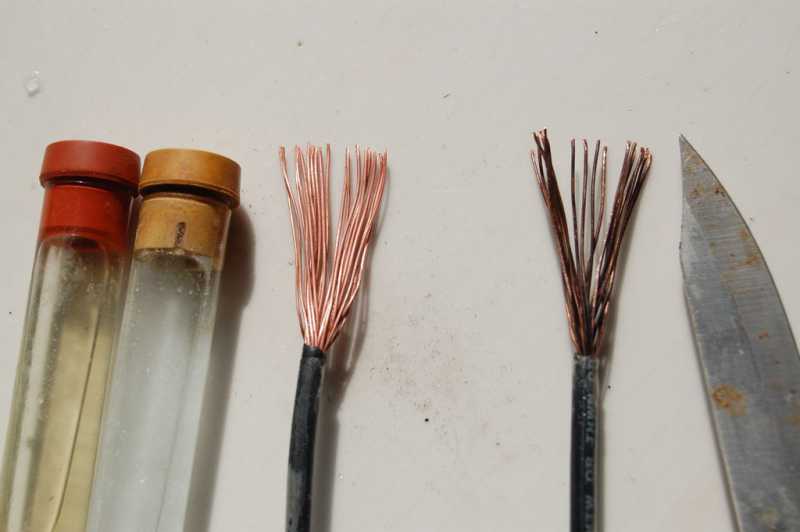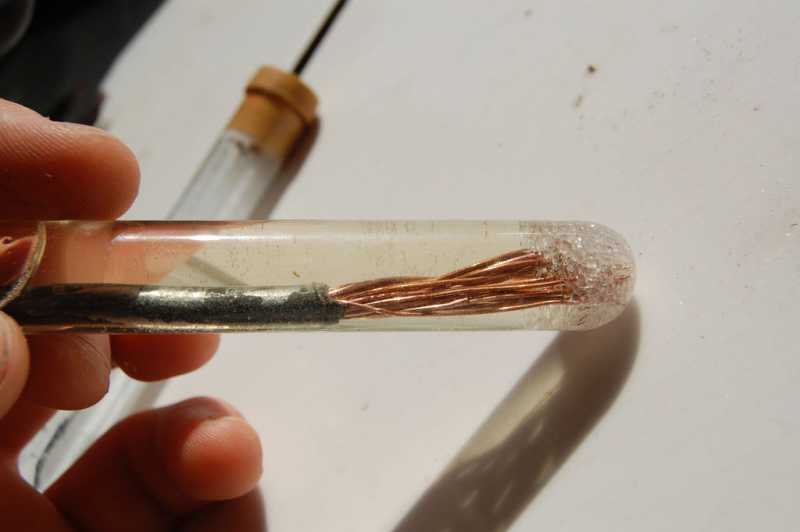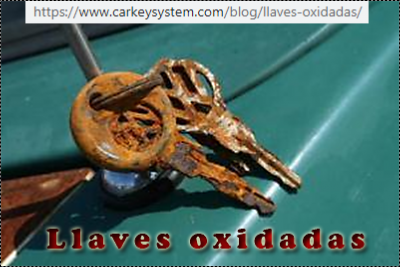Hola,
Buscando cómo limpiar cables de cobre oxidados, he visto esta web de instructables
escrita por en NH7ZE solomonhorses y electronics
- Este proceso utiliza dos soluciones conjuntamente;
· Una de sal de mesa y vinagre.
· La otra solución es bicarbonato de sodio y agua.
Here is an old ham radio operators trick for cleaning wires for soldering that are old and corroded. It is hard to find this technique printed anywhere! I am a ham, NH7ZE, and learned it from my elmer (mentor). I am passing it on. I hope it helps people who need to clean wires:P Please vote!!!
Normally, if you strip a wire, and see it is corroded, there is not much you can do to restore it's shiny new conductive properties. There is scraping and scratching which comes to mind, but you'll never get it to the solderable slickness it once was long ago. After laboring and fretting over the corroded pieces of wire for a long, long time, you see that your sweat coming out of your palms and fingers are corroding the copper AGAIN!!!! Oh, dear. NOT TO WORRY!!!!! Give yourself a pat on the back, because what you will pull out of your bag of tricks now, will send all the corroded copper wires scurrying and scampering away in fear!!!! Here is how to clean any corroded wire without even touching it, in 30 seconds!! And what's more, you can even solder it!!!
This process uses two solutions, one is regular table salt and vinegar. Any kind of vinegar will work, from balsamic, to rice, to white vinegars. Its the acidity and corrosiveness of the salt and vinegar together that you want. The other solution is Sodium Bicarbonate, or baking soda, and water. This is used to neutralize the corrosive properties of the other solution, and to further clean the wires.
Step 1: Strip the wires to be cleaned.
Step 2: Get 2 containers, one for each solution. They can be paper cups, plastic, glass, bowls, whatever you can find. I have vials, because I am a professional electronics installer and I use these solutions out in the field.
Step 3: Get 1 tablespoon of raw salt, and put it in one of the containers. Fill up the rest of the container with vinegar, and stir the both together. As a general rule of thumb, put as much salt in the vinegar as will dissolve.
Step 4: Get 1 tablespoon of Sodium Bicarbonate, (baking soda) and add it to the other container. Fill up the rest with water, and stir well. Add more baking soda to make it cloudy. The amount is not important, as long as it is alkaline to cancel the acid of the vinegar solution.
Step 5: Put the stripped end of the wire in the vinegar solution, and stir the solution with the wire. any wire you want cleaned needs to be under the solution. Movement of the wire in the liquid speeds up the process.
Step 6: After 2 minutes or so, the wire will look very shiny and new in the vinegar solution. The acid and salt in the solution is etching away the oxides, exposing the bare metal. Make sure the metal is uniformly shiny. Leave it in longer if it is not perfectly clean throughout.
Step 7: Once the wire is satisfactorily clean, remove the wire from the vinegar, and plunge it into the baking soda solution to neutralize the acid's corrosive properties. If the wire was exposed to the air, without neutralizing the acid first, it would quickly corrode again. The baking soda keeps it clean and shiny. Swish the wire around in the baking soda water for about 10 seconds, and then you are done!! Shiny new wire ready for soldering, and conducting once again!!
Please vote on this instructable!!
Thanks for reading.
- Información relacionada en:
· Ayuda cables oxidados
· Cable coaxial oxidado...
· Desmontaje de antena Oxidada
· Antena oxidada
· Pintura anti-oxido
· Fallo del cable por soldadura con oxido...
· Pasta conductora de grafito o Pasta antioxidante especial para aluminio Noalox...
· Rotor Oxidado...
· Limpiar conectores de antena del equipo
· Limpieza de las equipos y potenciómetros...
·El anodizado del aluminio
·
· Detector metal-oxido...
.
· 73 Carlos EA1DVY
·
Carlos EC1T
Ex. EA1DVY
Soria in81
Hola,
Carlos, muy interesante. No lo conocía.
Muchas gracias.
73, Máximo - EA1DDO
Máximo Martín - EA1DDO / HK1H / M0HAO
EA1DDO@HoTMaiL.com
http://www.EA1DDO.es
Para los que leeis francés, otra opción, pensada específicamente para permitir la soldadura en cables coaxiales que tienen oxidada la malla exterior.
Realiza una electrodeposición de cobre para recuperar el material perdido por la oxidación.
Procede del boletín ON0MR Revue de la Sección local de la UBA en Namur
Un saludo.
jon, ea2sn
Jon, EA2SN / AE2SN
... el que lee mucho y anda mucho vee mucho y sabe mucho. (Don Quijote, libro segundo, capítulo XXV)
Examinador Voluntario para la FCC (EE. UU.) con ARRL-VEC /.../ 4,69BDXCC como EE2A con una vertical y 5-100 W
Muchas gracias a ambos por la información. Es realmente de utilidad.
Es realmente de utilidad para los que cacharreamos con antenas de hilo y coaxiales con los años disponemos de un buen stock de cables y coaxiales viejos. Tarde o temprano tanto los cables de cobre como los coaxiales acaban impracticables para poder soldarlos o hacer buenas conexiones mecánicas que sean fiables desde un punto de vista eléctrico.
Fernando, EA3KU.
Fernando, EC3A (EC3AT 1979/1981 / EA3KU 1982-2020)
(socio 13494 - desde 1975)
Hola,
Buscando cómo limpiar llaves oxidadas, he visto esta web https://www.carkeysystem.com/copias-de-llaves-de-coche/
lo expongo aquí por si le puede interesar...
Como limpiar las llaves
Las llaves son un invento muy necesario en el que no reparamos demasiado, hasta que fallan, ahí nos damos cuenta repentinamente de su importancia.
Al ser metálicas y sólidas, pensamos que son eternas y nos olvidamos de ellas, como mucho conseguimos un llavero más o menos chulo y las enganchamos a éste. Pero es necesario mantenerlas en buen estado para que cumplan con su función, de lo contrario si se oxidan, puedes encontrarte con el problema de no poder abrir una puerta.
Lo más adecuado es darles de vez en cuando un baño en esencia de trementina.
Si ya estuvieran las llaves oxidadas, debes dejarlas en remojo durante unas horas, en un bol con vinagre de alcohol. Luego cepíllalas con un viejo cepillo de dientes y sécalas con un trapo. Si el óxido persiste en algunas partes repite la operación. Quedarán perfectas.
Un último consejo de conservación para llaves, es no acercarlas a ningún imán.
La necesidad de un buen mantenimiento también se aplica para las cerraduras, incluso en mayor grado, dada la facilidad de acumular polvo y suciedad en su mecanismo. Especialmente en puertas que apenas se utilizan, como sucede en los trasteros, segundas viviendas o patios. Para evitar que las cerraduras se atasquen recomendamos utilizar grafito como mejor alternativa. Es un lubricante sólido que se emplea sobre todo en ejes, bisagras y engranajes. Sus ventajas es que no retiene polvo, es muy durable y posee una alta resistencia.
Su apariencia es de polvo de color gris oscuro con brillo metálico. Se comercializa en recipientes con un aplicador que se coloca en la ranura de la cerradura para que el grafito se adhiera en su interior. Su precio suele ser bajo y te ahorrará muchos problemas. Una solución económica y que te puede salvar en caso de no tener un bote de grafito a mano es recurrir a un simple lápiz. Parece un truco de Mc Gyver, pero tiene su lógica: las minas de los lápices (los negros, no los de color) contienen grafito. Sólo tendrás que “pintar” los dientes de la llave con el lápiz e introducirla en la cerradura. Cuando gires la llave, el movimiento lubricará el mecanismo de la cerradura.
::: FIN :::
73 Carlos EC1T
Carlos EC1T
Ex. EA1DVY
Soria in81
Lo de la limpieza del cobre con sal y vinagre es antiguo. Recuerdo (sobre 1945/50) que cuando mataban un guarro para Navidad, las morcillas se cocían en peroles de cobre y se limpiaban con vinagre y sal. Quedaban relucientes. José Luis
QDURE - https://qsl.ure.es
Imprime y confirma tus QSL en tan solo tres click.
Nunca fue tan fácil y cómodo
el confirmar tus contactos.
TIENDA ONLINE URE
Publicaciones, mapas, polos, camisetas, gorras, tazas, forros polares y mucho más...
WEBCLUSTER EA4URE
Conoce el nuevo WebCluster de URE, ahora con nuevos filtros e información y compatible con GDURE





